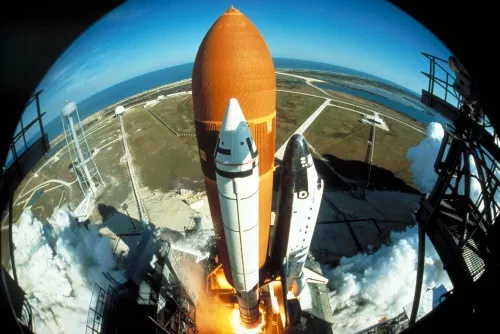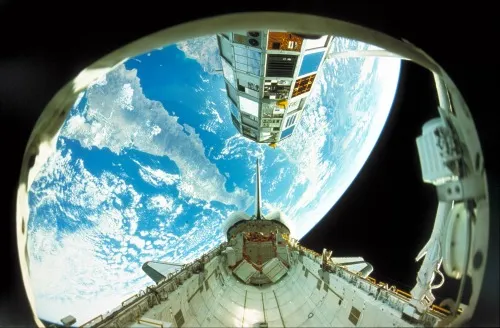How IMAX Pulled Spaceflight Down to Earth
The 1985 film that famously revealed the lives of astronauts in zero gravity returns to the big screen
/https://tf-cmsv2-smithsonianmag-media.s3.amazonaws.com/filer/20130402123037dream-is-alive-thumb.jpg)
Nearly 30 years ago, moviegoers got an unprecedented look into the lives of the space shuttle astronauts orbiting 280 miles above the Earth. And they witnessed it in extraordinary dimensions—on a five story-tall screen in booming surround sound.
The Dream Is Alive pulled back the curtain on NASA’s Space Shuttle program, giving the public an intimate glimpse into the previously unfamiliar lives of its members. Directed by IMAX co-inventor Graeme Ferguson and narrated by Walter Cronkite, the IMAX classic showed astronauts in full garb, practicing how to move in weightless conditions, using a water tank on land. Once in space, the film revealed the crew’s reactions to watching the world turn as the orbiter circled the Earth at 17,000 miles an hour. It followed the men and women as they worked, ate, exercised and even slept in zero gravity.
“Astronauts have said it’s the next best thing to being there,” says Valerie Neal, the space shuttle curator at the Smithsonian National Air and Space Museum, of the film that was originally released in 1985. “The theater kind of dissolves and you feel like a part of the film. I had this sense that I was in space with them.”
Shot by 14 NASA astronauts during three shuttle missions, the film includes footage of Discovery‘s 1984 launch and landing, as well as the deployment of several satellites from the spacecraft. It features sweeping panoramas of the Earth, space walks and risky satellite repairs. It puts the audience in the driver’s seat with video filmed from the astronauts’ points of view while training on land—viewers feel as if they are parachuting to the ground, or lurching away from the shuttle in high-speed emergency baskets.

The film premiered during an optimistic time for space exploration—1984 saw nine shuttle missions, seven more than in the program’s first year in 1981. More than 100 missions would launch into space in the next three decades before the program folded in 2011. The Dream Is Alive represented the country’s drive to make space transportation routine. It also introduced the public to a new era of American astronauts, Neal says, one that included women and individuals from more diverse backgrounds.
“That was something of a revelation, and I think it probably played a role in widespread acceptance that this is the way spaceflight should be,” she says. “It shouldn’t be just the cream of the crop of the most elite military jet test pilots, but also people who are scientists and engineers who could be our next door neighbors.”
In the film viewers saw Sally Ride, the first American woman in space, hover in midair while working with her fellow Challenger crew members. Kathy Sullivan joins her, marking the first time two women flew together on a shuttle mission. We watch Sullivan become the first American woman to walk in space as she waves to the camera from outside the window, the white and blue of the Earth swirling behind her. We see Judith Resnik, the first Jewish woman in space, working in weightlessness. To date, more than 50 American women have become NASA astronauts.
The Dream Is Alive was still playing in theaters when Challenger exploded seconds after its 10th launch in January 1986, killing all seven astronauts onboard, including Resnik. The tragedy illuminated the very real dangers of space travel, an aspect of the shuttle program that The Dream hadn’t explored. But Neal says the United States soon saw a surge of public support for the program, suggesting the golden age of American space exploration was not yet over.

“The American public had a sense that the space program was valuable and shouldn’t be halted,” she says.
Now, another generation of space enthusiasts can experience the zenith of the shuttle program, this time on an 86-by-62 foot silver screen. The Dream Is Alive is now showing in the Airbus IMAX Theater in the National Air and Space Museum’s Steven F. Udvar-Hazy Center in Chantilly, Virginia. Showtimes and ticket information is available here.
The film temporarily joins two of its stars at the Smithsonian. One of the cameras used in the film, which went on to document missions until 1998, arrived at the Institution last April and will soon be installed at the Air and Space Museum’s “Moving Beyond Earth” exhibition. The black camera, which weighs about 80 pounds, shot film with over-sized, 70mm frames, providing more than eight times the area of traditional 35mm film. Such capacity lent to never-seen-before, wide-angle views of the planet’s topography. The space shuttle Discovery landed at the museum shortly after. The famed spacecraft spent 365 days in space during its 27-year career. It flew 39 missions, several of which are chronicled in the film, before it was retired in 2011.
/https://tf-cmsv2-smithsonianmag-media.s3.amazonaws.com/accounts/headshot/marina-koren-240.jpg)
/https://tf-cmsv2-smithsonianmag-media.s3.amazonaws.com/accounts/headshot/marina-koren-240.jpg)